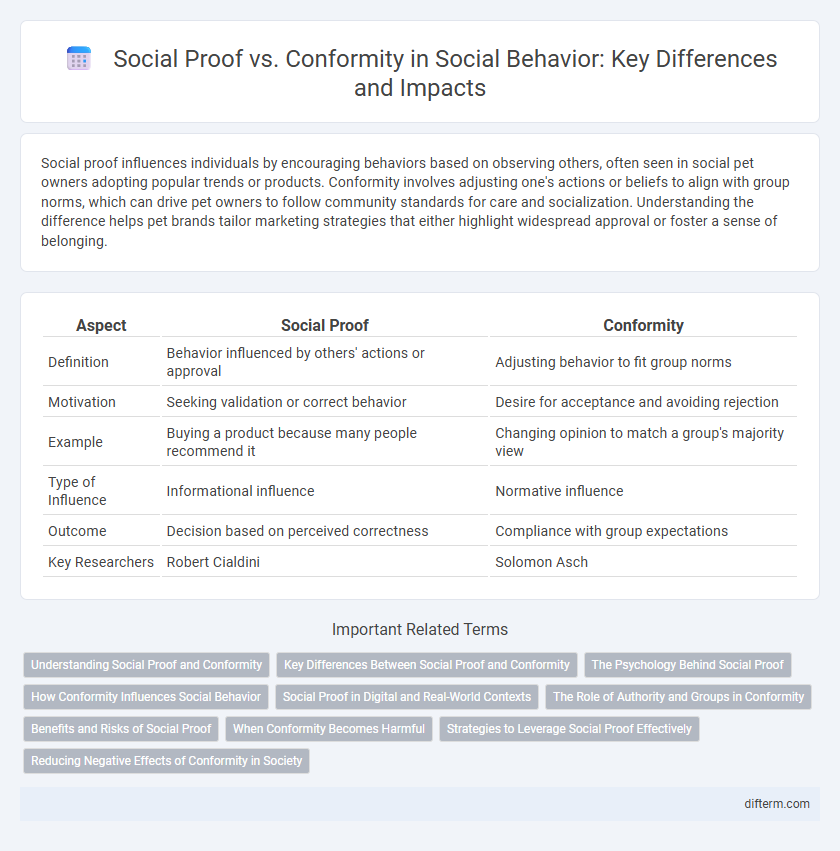Social proof influences individuals by encouraging behaviors based on observing others, often seen in social pet owners adopting popular trends or products. Conformity involves adjusting one's actions or beliefs to align with group norms, which can drive pet owners to follow community standards for care and socialization. Understanding the difference helps pet brands tailor marketing strategies that either highlight widespread approval or foster a sense of belonging.
Table of Comparison
| Aspect | Social Proof | Conformity |
|---|---|---|
| Definition | Behavior influenced by others' actions or approval | Adjusting behavior to fit group norms |
| Motivation | Seeking validation or correct behavior | Desire for acceptance and avoiding rejection |
| Example | Buying a product because many people recommend it | Changing opinion to match a group's majority view |
| Type of Influence | Informational influence | Normative influence |
| Outcome | Decision based on perceived correctness | Compliance with group expectations |
| Key Researchers | Robert Cialdini | Solomon Asch |
Understanding Social Proof and Conformity
Social proof occurs when individuals mimic the actions of others under the assumption that those actions reflect correct behavior, influencing decision-making in uncertain situations. Conformity involves aligning attitudes, beliefs, or behaviors with group norms to gain acceptance or avoid social rejection. Understanding these phenomena highlights how social influence shapes individual actions through implicit pressures versus explicit consensus.
Key Differences Between Social Proof and Conformity
Social proof involves individuals copying behaviors based on perceived popularity or consensus to make decisions, whereas conformity emphasizes aligning attitudes and beliefs to match group norms. Social proof is often driven by uncertainty and the desire for accurate information, while conformity stems from social pressure and the need for acceptance. Key differences include the underlying motivation, with social proof rooted in informational influence and conformity in normative influence.
The Psychology Behind Social Proof
Social proof operates on the psychological principle of informational social influence, where individuals look to others' behavior to guide their own actions in uncertain situations. This phenomenon is driven by the human need for accuracy and the desire to make correct decisions based on observed group behavior. Unlike conformity, which often stems from normative social influence and a need for acceptance, social proof emphasizes cognitive processes that validate beliefs through external evidence.
How Conformity Influences Social Behavior
Conformity significantly shapes social behavior by compelling individuals to align their actions and beliefs with group norms, enhancing group cohesion and acceptance. This influence often overrides personal preferences, as the desire to avoid social rejection or gain approval drives uniform behavior within social settings. Understanding conformity reveals how social pressure molds collective behavior, impacting decision-making, attitudes, and social interactions.
Social Proof in Digital and Real-World Contexts
Social proof plays a crucial role in shaping decisions by leveraging visible cues such as reviews, testimonials, and user engagement metrics both online and offline. In digital contexts, high ratings and abundant positive feedback boost trust and influence consumer behavior, while in real-world environments, actions like queue formation and majority behaviors guide individual choices. Understanding these dynamics helps brands and individuals harness social proof effectively to drive engagement and adoption.
The Role of Authority and Groups in Conformity
Authority figures significantly influence social proof by setting behavioral standards that individuals often follow to gain approval or avoid conflict. Groups reinforce conformity through social norms, creating pressure to align behaviors and attitudes with collective expectations. This dynamic illustrates how authority and group membership shape decision-making processes and social behavior compliance.
Benefits and Risks of Social Proof
Social proof leverages the influence of others' behaviors and opinions to guide decision-making, enhancing trust and reducing uncertainty in social situations. Benefits include increased credibility, faster consensus, and improved social cohesion, while risks involve the perpetuation of misinformation, herd mentality, and loss of individuality. Understanding these dynamics helps balance conformity pressures with critical thinking for healthier social interactions.
When Conformity Becomes Harmful
Conformity becomes harmful when individuals suppress their own values and critical thinking to align with group norms, leading to unethical behavior or poor decision-making. Social proof, while useful for providing guidance in uncertain situations, can escalate into dangerous herd mentality if blindly followed. Recognizing the distinction between adaptive social proof and detrimental conformity is essential to maintaining autonomy and fostering ethical social environments.
Strategies to Leverage Social Proof Effectively
Strategies to leverage social proof effectively include showcasing authentic customer testimonials and user-generated content to build trust and credibility. Highlighting real-time user interactions and displaying social media follower counts or product usage statistics can enhance perceived popularity and influence decision-making. Employing case studies and expert endorsements further reinforces reliability, encouraging potential customers to align with proven choices.
Reducing Negative Effects of Conformity in Society
Reducing negative effects of conformity in society involves fostering critical thinking and encouraging diverse perspectives to challenge prevailing norms. Promoting social proof that highlights positive, inclusive behaviors can counteract blind conformity and support healthier group dynamics. Empowering individuals with awareness of conformity pressures enables more authentic decision-making and resilience against negative social influences.
social proof vs conformity Infographic

 difterm.com
difterm.com